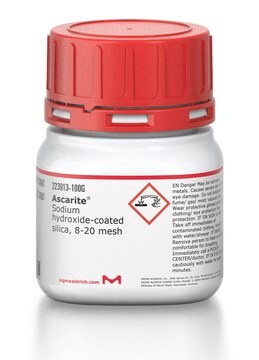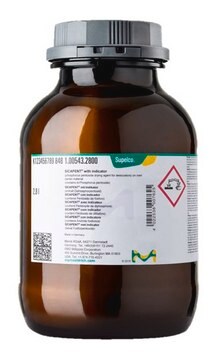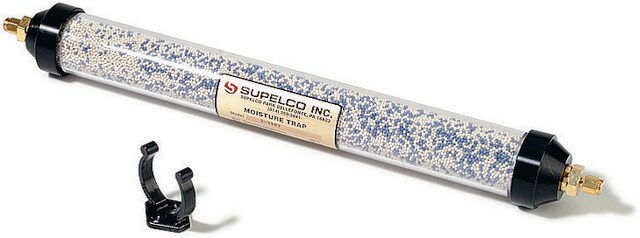Wszystkie zdjęcia(3)
Kluczowe dokumenty
223921
Ascarite®
Sodium hydroxide-coated silica, 20-30 mesh
Synonim(y):
Askarytowy adsorbentCO2
Zaloguj sięWyświetlanie cen organizacyjnych i kontraktowych
About This Item
Polecane produkty
Poziom jakości
Formularz
granular
wielkość cząstki
20-30 mesh
ciąg SMILES
[Na+].[O-H]
InChI
1S/Na.H2O/h;1H2/q+1;/p-1
Klucz InChI
HEMHJVSKTPXQMS-UHFFFAOYSA-M
Szukasz podobnych produktów? Odwiedź Przewodnik dotyczący porównywania produktów
Opis ogólny
Ascarite® is sodium hydroxide coated silica mainly used as carbon dioxide adsorbents. It is the second generation of the original Ascarite, which was derived from granular asbestos. Ascarite rapidly and quantitatively adsorbs carbon dioxide, (and acid gases), and is useful in a number of analytical and microanalytical procedures, physiological studies, etc.
Zastosowanie
Ascarite® can be used as a carbon dioxide (CO2) trap.
Cechy i korzyści
The material is self-indicating, gradually changing color (to white) within a narrow zone due to the formation of sodium carbonate.
Informacje prawne
Ascarite is a registered trademark of Arthur H. Thomas Co.
Ta strona może zawierać tekst przetłumaczony maszynowo.
Hasło ostrzegawcze
Danger
Zwroty wskazujące rodzaj zagrożenia
Zwroty wskazujące środki ostrożności
Klasyfikacja zagrożeń
Eye Dam. 1 - Met. Corr. 1 - Skin Corr. 1A
Kod klasy składowania
8B - Non-combustible corrosive hazardous materials
Klasa zagrożenia wodnego (WGK)
WGK 3
Temperatura zapłonu (°F)
Not applicable
Temperatura zapłonu (°C)
Not applicable
Środki ochrony indywidualnej
Eyeshields, Faceshields, Gloves, type P3 (EN 143) respirator cartridges
Wybierz jedną z najnowszych wersji:
Masz już ten produkt?
Dokumenty związane z niedawno zakupionymi produktami zostały zamieszczone w Bibliotece dokumentów.
Klienci oglądali również te produkty
Reduction of [11C] CO2 to [11C] CO using solid supported zinc.
Dahl K, et al.
Journal of Labelled Compounds & Radiopharmaceuticals, 60(13), 624-628 (2017)
Highly selective iron-based Fischer?Tropsch catalysts activated by CO2-containing syngas
Chun D H, et al.
J. Catal., 317, 135-143 (2014)
Weiqing Liu et al.
Carbohydrate polymers, 93(1), 199-206 (2013-03-08)
Dissolution of waxy corn starch in 1-ethyl-3-methylimidazolium acetate (EMIMAc) was qualitatively studied and compared with gelatinisation process in water. The rheological properties of starch-EMIMAc solutions were investigated in dilute and semi-dilute regions, from 0.1 to 10 wt% over temperature range
Qiang Yu et al.
Bioresource technology, 129, 592-598 (2013-01-12)
Liquid hot water (LHW), dilute hydrochloric acid (HCl) and dilute sodium hydroxide (NaOH) were applied to sugarcane bagasse (SB). Application of the same analytical methods and material balance approaches facilitated meaningful comparisons of glucose and xylose yields from combined pretreatment
Xin-Cun Yao et al.
Carbohydrate polymers, 94(1), 88-90 (2013-04-03)
Most polysaccharides cannot dissolve in water but can be hydrolysed using hydrogen peroxide (H2O2) to yield a water-soluble product. This study presents a method of preparing water-soluble polysaccharides from peach gum by hydrolysis using H2O2. Extraction was monitored by the
Global Trade Item Number
| SKU | GTIN |
|---|---|
| S220744-1EA | |
| 223921-100G | 4061838778826 |
| 223921-2.5KG | 4061833545348 |
| 223921-500G | 4061835252879 |
Nasz zespół naukowców ma doświadczenie we wszystkich obszarach badań, w tym w naukach przyrodniczych, materiałoznawstwie, syntezie chemicznej, chromatografii, analityce i wielu innych dziedzinach.
Skontaktuj się z zespołem ds. pomocy technicznej







